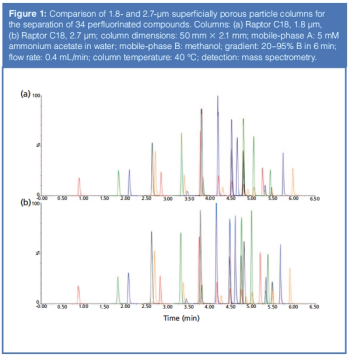
LCGC Europe
Click the title above to open the LCGC Europe June 2018 regular issue in an interactive PDF format.

LCGC Europe
Click the title above to open the LCGC Europe June 2018 regular issue in an interactive PDF format.

LCGC Europe
Comprehensive two-dimensional liquid chromatography (2D-LC) was used for detailed profiling of various nonionic ethoxylated surfactants applied in pharmaceutical formulations. Hydrophilic-interaction chromatography (HILIC) and reversed-phase liquid chromatography (LC) were used as the first and second dimensions, respectively. Detection was performed with evaporative light-scattering detection (ELSD) for general profiling and with single-quadrupole mass spectrometry (MS) for structure elucidation of individual peaks and for class-type confirmation of peak-groups.

LCGC Europe
The use of superficially porous particles (SPPs) for modern high performance liquid chromatography (HPLC) is now very common. Initially, SPPs rose as an alternative to sub-2-µm fully porous particles (FPPs). In recent years, many column manufacturers have developed 2-µm and smaller SPP-based products. This article investigates the practical utility of these smaller SPP designs.

LCGC Europe
While capillary gas chromatography has been undergoing a renaissance, with new columns, detectors, data systems, and multidimensional separations, the classical inlets have remained the same: We are still injecting liquid samples with syringes into split and splitless inlets, as we have for nearly 50 years. Split and splitless injections present several well-known and some not-so-well known challenges, mostly arising from heating of the inlet, that make sample injection and inlets a major hurdle for gas chromatographers. These challenges and some ideas for mitigating them are discussed and a case is made for renewed exploration of the cool inlets and injection techniques: cool on-column and programmed temperature vaporization.

LCGC Europe
The 32nd International Symposium on Chromatography (ISC 2018) will be held on 23–27 September 2018 in Cannes-Mandelieu, France.

LCGC Europe
This is the first of three articles looking at the impact of the new United States Pharmacopeia (USP) chapter on Analytical Instrument Qualification (AIQ) on data integrity in a regulated chromatography labora-tory. In part 1, user specifications for chromatography systems and the relationship between users and sup-pliers will be discussed.

LCGC Europe
The Chromatographic Society and the Royal Society of Chemistry Analytical Division North East Region has organized a meeting to be held on 22 November 2018 in the Stadium of Light, Sunderland, UK.